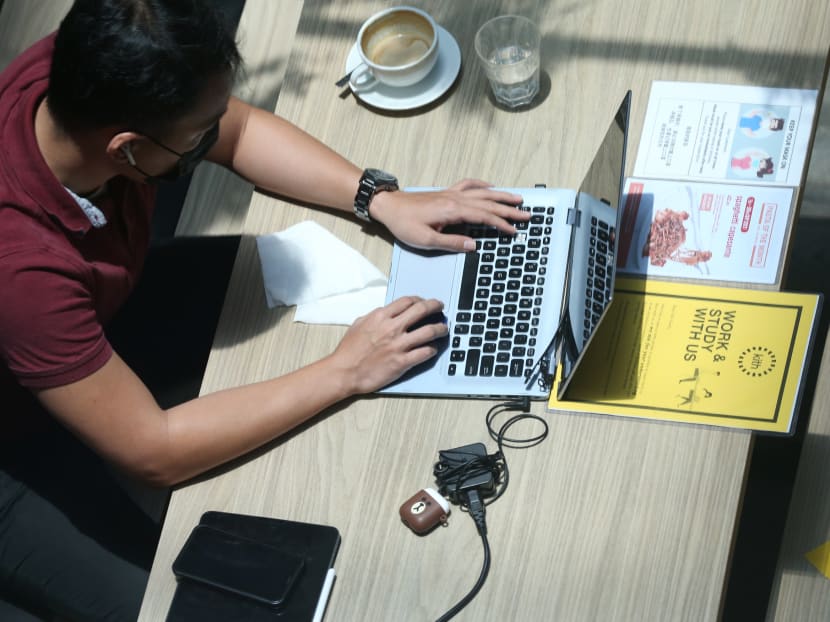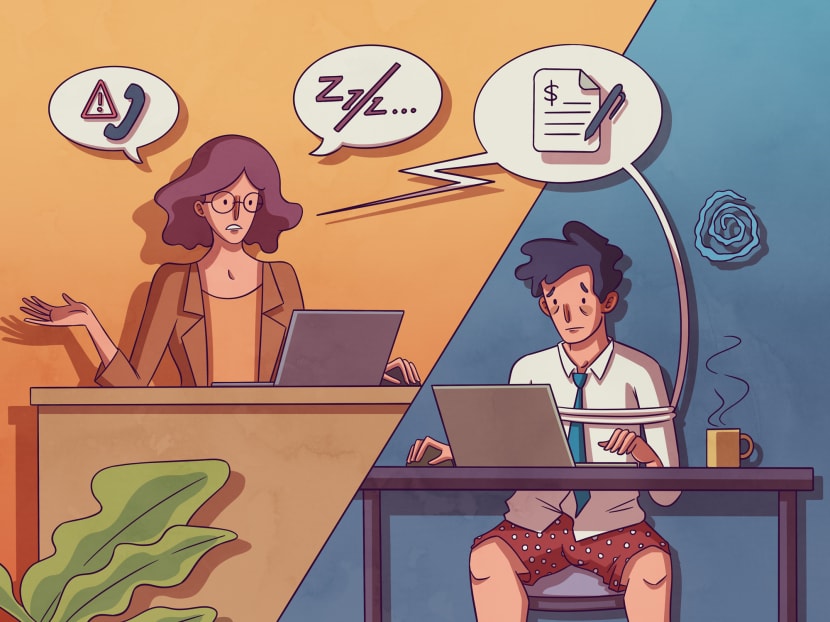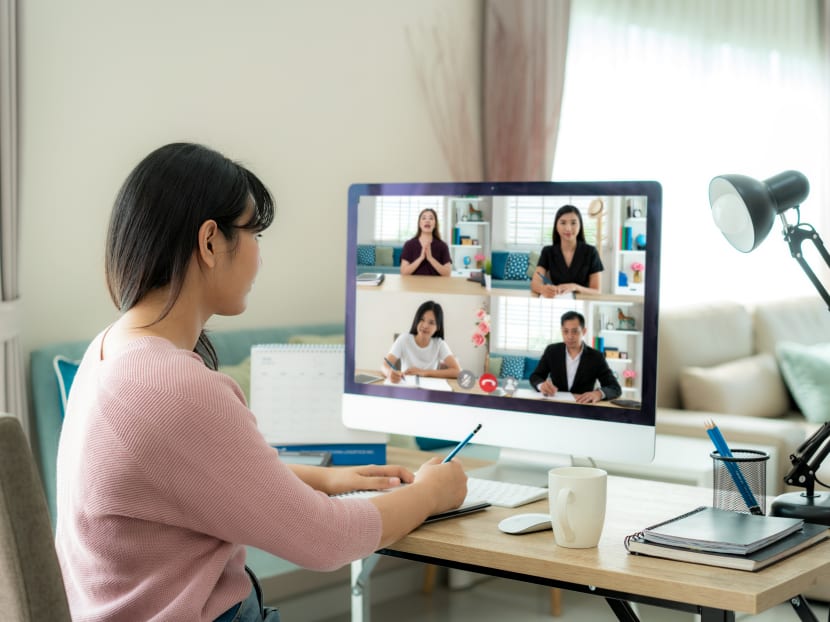The Big Read in short: As employees embrace remote working, bosses try to overcome trust issues
Each week, TODAY's long-running Big Read series delves into the trends and issues that matter. This week, we look at how companies and employees are adapting to work-from-anywhere arrangements which are set to stay. This is a shortened version of the full feature.

Some negative work-from-home experiences — arising from either the workers’ own insecurity or their bosses’ penchant to micromanage, or both — have led some employees whom TODAY spoke to to quit their jobs despite the uncertain economic outlook.
Each week, TODAY's long-running Big Read series delves into the trends and issues that matter. This week, we look at how companies and employees are adapting to work-from-anywhere arrangements which are set to stay. This is a shortened version of the full feature, which can be found here.
- Even though remote working has become a way of life for many in Singapore, employers and employees are still trying to find the mutually optimal arrangements
- Commonly cited issues that need to be addressed centre around trust, productivity and mental health
- Human resource experts say embracing work-from-home or work-from-anywhere is the only way forward and companies who do not do so will lose out on talent
- However, employees also have to exercise self-responsibility over how they manage their own work
SINGAPORE — While working from home, Cheryl (not her real name) was not required, at least officially, to be at her desk all the time. Yet, she still felt pressured to give her then employers that very impression.
To prevent her status on communication platforms such as Microsoft Teams or Skype for Business from turning “inactive”, the marketing professional would go back to her desk to move her mouse every 10 minutes or so even though she had to step away for a while.
In order for her managers to monitor what she was doing, she also had to make all her work calls, including to external parties, through Microsoft Teams. Such a practice, as well as her managers’ throwaway remarks during virtual meetings, made her feel like she was being tracked.
“From the things that they said — like ‘nowadays, we don’t hear anything from this person, is she even working?’ — it made me paranoid about myself, even though it was not directed to me,” said Cheryl, now 29, who left the company in November last year after about 12 months on the job.
Such negative work-from-home experiences — arising from either the workers’ own insecurity or their bosses’ penchant to micromanage, or both — have led some employees whom TODAY spoke to to quit their jobs despite the uncertain economic outlook.
For Michelle (not her real name), a graphic and web designer in her 30s, she actually changed jobs twice within the last 18 months as she felt that both of her former employers had little regard for staff well-being.
When work-from-home was first implemented at the company she worked at during the circuit breaker from April to June last year, Michelle said her supervisors would keep tabs on whether the staff were online or not through Microsoft Teams.
“They kept hyperfixating on the red dot (inactive) and green dot (online)... And they would use that later on during group meetings where they could verbally scold people: ‘Your work is only this much because you haven’t been online you know’,” she said.
She soon left to join another firm — only to witness how it continuously ignored Covid-19 rules. Frustrated at the disregard for staff well-being, she left this company after about one year.
Nearly two years after work-from-home was foisted upon many organisations amid an unprecedented coronavirus pandemic, issues such as ensuring productivity and developing mutual trust from a distance continue to dog both employees and employers alike.
And it looks like something they will still be grappling with in the foreseeable future.
From Monday (Sept 27), work-from-home will once again be the default arrangement in Singapore until Oct 24, as the Government introduced new restrictions to halt a surge in Covid-19 infections, which have climbed to more than 1,000 cases on some days.
Human resource experts told TODAY that more than ever, it is important for employers to focus on “trust” issues, such as incorporating building trust in their approach to leadership and management.
Ms Rachele Focardi, a future of work strategist, said: “As far as Singapore organisations (are concerned), if the last 15 years have shown us anything, it is that not moving along with the times, creating the best possible environment for employees and adapting to the needs of the new generations is not an option.”

FIRMS’ INITIAL CHALLENGES
While remote work has proved to be a boon for many — such as savings in commuting time for employees and office space rental for employers — some companies told TODAY that they were initially concerned about how such a work arrangement would affect organisational results and productivity.
Mr Lim Hong Zhuang, chief executive officer of blockchain start-up ShuttleOne, said one major concern he had was keeping his employees engaged and ensuring they collaborated with one another while working from home.
“Also, how do we get the attention of our employees with so many things that may distract them, like having WhatsApp open on the browser, during calls et cetera,” he said.
Nevertheless, some employers said they have managed to come around after a period of trial and error searching for the optimal arrangement.
Mr Leong Chee Tung, chief executive officer of human resource startup EngageRocket, said his company had initially held video meetings quite regularly, thinking that such sessions were important to prevent its employees from losing touch with each other and “switching off”.
However, over the months, Mr Leong realised that his employees found it draining and detrimental to their mental health. As such, the management has decided that attendance at most video meetings is no longer mandatory.
For Mr Lim, his company took about one year to settle on what would work for them.
“We were evaluating all the tools available and being nimble in changing. We changed email dashboards, many tools,” he said.
Some other companies, especially non-tech ones, found the transition to work-from-home to be harder, however.
Ms Koh Qin Wen, a general manager at an education company, said she does not micro-manage and will accept it when her staff tells her that they don’t have the time or resources to take on additional projects. However, there is a part of her that still questions such responses at times.
“There is always the thought of ‘could they do more, could they do better?’ At the end of the day, if the results show, then it is fine. But I always wonder whether they are actually working the full 40 hours per week or not,” she said.
POLICIES AND PRACTICES IN PLACE
To compensate for the lack of human interaction, some companies have implemented various measures, such as weekly or daily virtual meetings for staff, to provide work updates.
Team bonding events are held virtually, such as group exercises or discussions on mental health, or virtual coffee breaks.
Several firms have also incorporated several software tools that they had not used pre-pandemic into their workflow processes.
Mr Lim’s blockchain firm uses a tool where each employee’s task is listed on a virtual board that can be seen by everyone, and staff can check off each task when they are done, after which a report would be sent to him for review.
Work calls and tasks are also organised into strict 90-minute sessions as that is the maximum duration people can stay focused, said Mr Lim.
While Mr Chionh Chye Kit, chief executive officer of regulatory tech firm Cynopsis, does not place restrictions on where his staff could do their work, they are discouraged from heading to food and beverage outlets.
“I would rather my people not work in the cafe because they are exposed to a mask-off environment for an extended period of time,” he said.
Mr Oo Gin Lee, the managing director of public relations firm Gloo, said that he is exploring options with a co-working space operator, where his staff will be able to work at co-working spaces near their homes just by booking a hotdesk or a meeting room via a mobile application called Switch.
“We have (an office in) central location, but people who live in Tampines, Jurong cannot go back to work, so they can use Switch to go to a nearby hot desk,” he said, adding that such an arrangement will also benefit staff who can’t work from home for various reasons.
On Friday, the Tripartite Alliance for Fair & Progressive Employment Practices released a series of guides, which contain best practices that companies can implement to foster better work-life balance, even as these two spheres have been increasingly blurred with work-from-home becoming dominant.

Mr Victor Mills, chief executive of Singapore International Chamber of Commerce, said that the guide on work-life practices which his team developed lays out how the management should set the broader strategy of what values the company stands for, how middle-level managers should implement it and how employees should exercise self-responsibility and make an effort to look after themselves.
Among the series of guides is also one on how companies can limit after-hours communication. One example is to implement a rostering system for staff who are in roles where they have to be contactable all the time, said Mr Daniel Chia, head of human resources at Samsung Electronics, who was also involved in drawing up the guides.
Building a workplace culture where employees feel appreciated and respected would be key in developing a set of best practices for one’s company, said Dr Michael Heng, director of People Worldwide Consulting.
And these can be small actions, such as praising employees when they perform well, or passing on the contact of a babysitter if any staff is facing problems with childcare.
Dr Heng said that other work-from-home best practices include providing laptops for staff, redefining methods to measure job performance, giving feedback and discussing ideas more regularly and being transparent with how the company is doing.
EMPLOYEES’ EXPERIENCES
While some employees have to deal with micromanaging bosses owing to a lack of trust, there are others with more positive experiences.
Mr Elston Aw, 31, who works remotely in Singapore for a start-up based in New York, said that his managers do not track how long he works as long as he makes himself available for meetings late at night here due to time zone differences, and completes his task.
The software engineer said that the flexibility afforded by his company is one reason he decided to take on this role full-time after interning and part-timing for them while he was an undergraduate.
“I want to work feeling like I am a creative, rather than being monitored and being a cog in the machine,” he said.
Apart from trust, one other issue that has cropped up when work-from-home started was concerns over employee productivity.
Mr Ong Bo Xian, 31, said subconsciously, he has this feeling that any time of the day can be used for work due to the lack of separation between home and the office.
“There is this psychological lure, a seduction into being more relaxed and not so hard on yourself during the work day because you know you can catch up later,” said Mr Ong, who works as a legal counsel.
While he is taking a longer time to complete his work, he said his output has not been affected, as it is offset by the fact that he saves time on commuting.
LIKE IT OR NOT, THE FUTURE IS HERE
Whether they like it or not, companies have no option but to embrace work-from-anywhere arrangements. There is no way they can return to the traditional work arrangement even after Covid-19 is fully brought under control, human resource experts told TODAY.
Hence, allowing staff some degree of remote or flexible work is the only way forward, they noted.
Even so, unfortunately, many companies still seem to think that things are going to return to pre-pandemic days, said Mr Mayank Parekh, chief executive officer of Institute for Human Resource Professionals.
“What will happen is that if you want to have good talent, if you want to position your company well in particular for the younger workforce, then I think you need to accept this as a given,” he added.
Nevertheless, it takes two hands to clap. Employees also need to exercise self-responsibility.
“So I think there is a limit to what the company can do. Opportunities are there, but individuals also have to step up,” said Mr Mayank.








